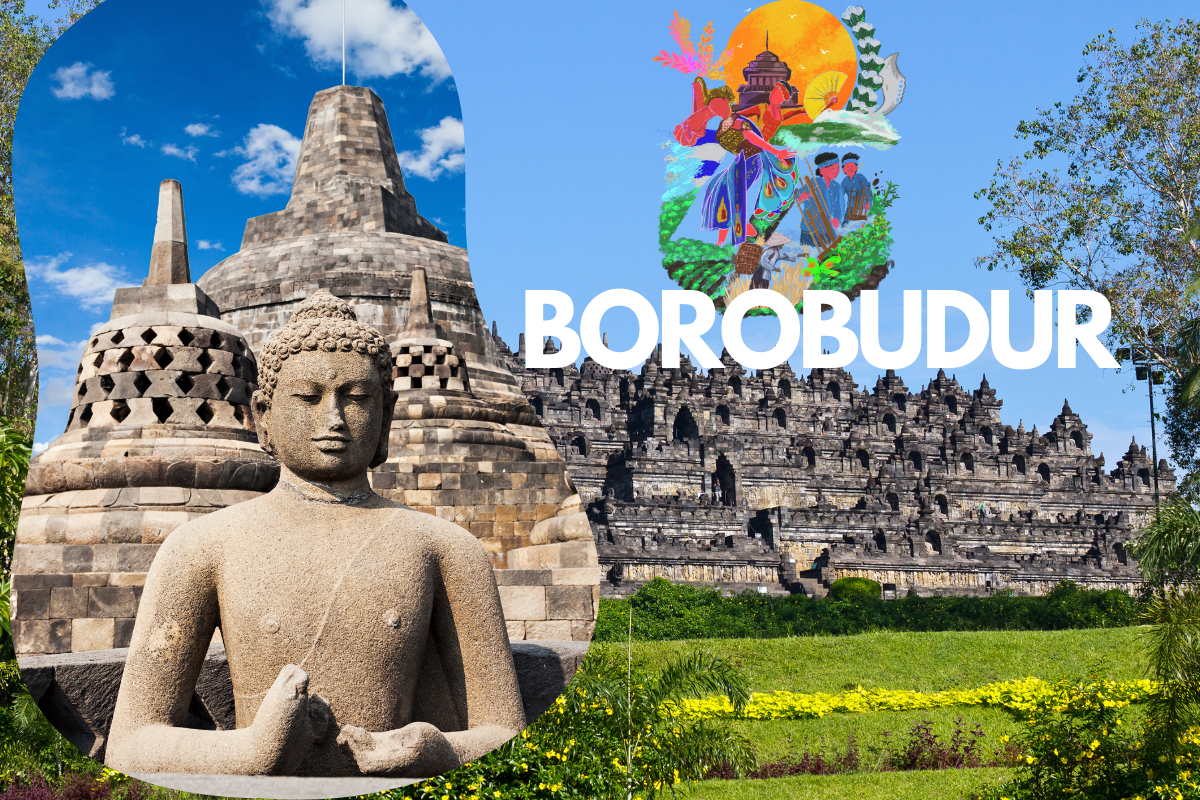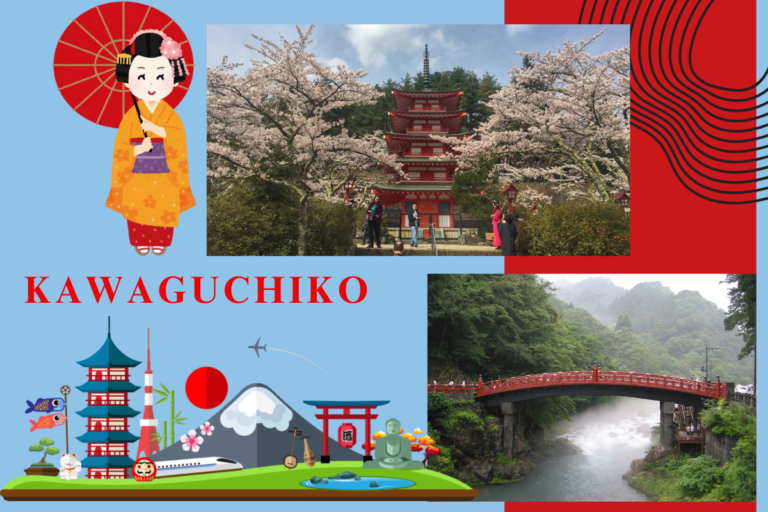Borobudur: A Complete Guide About UNESCO World Heritage Site
Borobudur is one of the world’s most amazing ancient monuments. Located on the Indonesian island of Java, it’s a massive, pyramid-like structure that dates back to the 9th century.
It is a picture of a giant stone building covered with intricate carvings and statues, sitting in the middle of a lush green landscape.
It’s a sight that leaves everyone who visits in awe. Borobudur attracts pilgrims, historians, and travellers from around the globe, each drawn by its profound serenity and intricate carvings.
Learn everything in this article about the cultural events, nearby places and guided tours you should not miss!
Significance as a UNESCO World Heritage Site
Borobudur isn’t just any old monument, it’s a UNESCO World Heritage Site. This means it’s recognised as being of exceptional importance to the collective interests of humanity.
UNESCO designation helps protect and preserve it, ensuring that people from all over the world can continue to visit and appreciate its beauty and significance.
Additionally, Borobudur’s inclusion on the World Heritage list draws attention to its exceptional significance and facilitates the acquisition of around-the-world support for its preservation.
Importance In Culture and History
In terms of cultural and historical significance, Borobudur stands out in many ways. It’s the largest Buddhist temple in the world, built during a time when Buddhism was flourishing in Indonesia.
The structure itself tells a story through its thousands of relief panels, which depict scenes from Buddhist teachings and Javanese life over a thousand years ago.
This makes Borobudur not only a place of worship but also a historical record of the culture and society of that era.
For the local community, Borobudur is a symbol of pride and a connection to their past. It attracts pilgrims and tourists alike, playing a big role in both religious practices and the local economy.
Whether you’re a history buff, a spiritual seeker, or just someone who loves amazing architecture, Borobudur offers something special.
It’s a place where you can literally walk through history and feel the echoes of the past in every step.
The Amazing Architecture of Borobudur
Borobudur is like a massive stone puzzle, perfectly pieced together. It’s a huge Buddhist temple made up of layers. Imagine it like a giant wedding cake with three main levels, which are:
1. The Base: This is the foundation and represents the world of desire and attachment. It’s like the ground level where most of us start our journey.
2. The Middle: This part is made up of five square terraces stacked on top of each other. It symbolises the world of forms where we start to free ourselves from desires.
3. The Top: Here, you find three circular platforms leading up to the main stupa at the very top. This represents the world of formlessness, where we’re free from worldly things.
Symbolism in the Design of Borobudur
Borobudur isn’t just a bunch of stones stacked together, it’s full of meaning and stories. Here are some symbolic elements of it:
1. Stupas: These bell-shaped structures are everywhere, especially on the top level. They symbolise the universe and are meant to house relics of the Buddha.
2. Terraces: The terraces are like steps in a spiritual journey. The lower ones are more about everyday life and struggles, while the higher ones represent reaching enlightenment.
3. Buddha Statues: There are hundreds of Buddha statues in various poses, each representing different teachings of Buddhism. Some are inside stupas, peeking out from small openings.
Unique Features of the Design of Borobudur
What makes Borobudur stand out are its intricate details and artistic elements. Here are 3 of its stunning features of design:
1. Carved Reliefs: The walls of Borobudur are covered in detailed carvings that tell stories from the life of the Buddha and other Buddhist teachings. It’s like a stone comic strip that you can follow as you walk around.
2. Narrative Panels: These panels are arranged in a specific order, guiding you through a spiritual journey. Each panel is a piece of a larger story, so as you move from one to the next, you’re taken on a visual and spiritual adventure.
3. Open-Air Design: Unlike other temples that are enclosed, Borobudur is open to the sky. This openness gives you a sense of connection to the universe and adds to the spiritual experience.
Borobudur is a place where architecture meets spirituality. It’s not just about looking at something beautiful, it’s about experiencing a journey through its design and symbols.
Role of Borobudur in Buddhist Rituals and Pilgrimages
The temple is designed as a giant mandala, which is a symbolic map of the universe. Buddhists believe that walking around and climbing up the different levels of Borobudur helps them move closer to enlightenment, which is a key goal in Buddhism.
It’s like a journey through different stages of spiritual awakening. Each step and level of Borobudur represents a part of this spiritual journey, starting from the base (which symbolizes the earthly realm) and moving up through layers that represent higher levels of enlightenment.
For centuries, people have travelled far and wide to visit this ancient temple, making it a central place for Buddhist worship and pilgrimages.
Cultural Events and Festivals at Borobudur
Here are two of the most celebrated festivals at Borobudur:
1. Waisak Festival (Vesak)
This is one of the biggest events at Borobudur, celebrating Buddha’s birth, enlightenment, and death. It usually takes place in May or June, depending on the lunar calendar.
You can picture thousands of people gathering with candles and lanterns. The whole area lights up, creating a magical and peaceful atmosphere.
Monks and visitors walk around the monument in a massive procession, making their way to the top while praying and meditating.
2. Borobudur Festival
It is a cultural festival that happens around the same time as Waisak, but it also includes music, dance, and arts from various Indonesian cultures.
The festival transforms Borobudur into a lively and colourful place with performances and exhibitions. It’s a great way to experience Indonesian culture beyond the historical site.
You can witness traditional dances, musical performances, and craft markets set up around the monument.
All about Getting to Borobudur
Here are the best ways to reach Borobudur from various locations:
1. From Jakarta
- Flight: The fastest way to get to Borobudur is to fly from Jakarta to Yogyakarta. The flight takes about 1 hour and 10 minutes. Once you land at Yogyakarta’s Adisutjipto International Airport, you can catch a taxi or private car to Borobudur, which is around 40 kilometres away and takes about an hour.
- Train: For a more scenic route, consider taking a train from Jakarta to Yogyakarta. The journey can take around 8-10 hours, depending on the type of train. From Yogyakarta’s train station, you can take a taxi or join a tour that includes transportation to Borobudur.
From Yogyakarta:
- Taxi or Private Car: The easiest way to reach Borobudur from Yogyakarta is by taxi or renting a private car. The drive takes about 1 hour. It’s a comfortable option if you’re travelling with a group or have a lot of luggage.
- Public Transport: If you’re on a budget, you can take a public minibus or bus from Yogyakarta’s city center to Borobudur. Be prepared for a longer and less direct route compared to a taxi.
Other Areas:
- Solo: If you’re coming from Solo (another nearby city), you can either drive, take a taxi, or catch a bus to Yogyakarta and then follow the above options to Borobudur.
- Bali: If you’re coming from Bali, you’ll first need to fly to Yogyakarta. After landing, follow the same options as above to reach Borobudur.
Transportation Options: Flights, Trains, and Local Transport
1. Flights: Flying into Yogyakarta is the quickest way to get close to Borobudur. Make sure to book your flight in advance, especially during peak tourist seasons. Taxis are readily available from the airport.
2. Trains: Trains from Jakarta to Yogyakarta offer a comfortable and scenic journey. Consider booking your train tickets early to get the best seats and prices. After arriving in Yogyakarta, you’ll need to arrange a taxi or tour to Borobudur.
3. Local Transport: Once you’re in Yogyakarta or Borobudur, you can use local taxis or hire a driver for the day. Many visitors also choose to join guided tours that include transportation, which can be convenient and informative.
Nearby Attractions
1. Prambanan Temple
Just a short drive from Borobudur, Prambanan is another incredible temple. It’s famous for its tall, skinny temples dedicated to Hindu gods.
It is the largest in Indonesia, known for its tall and pointed architecture. The architecture is stunning, and the intricate carvings are a real treat.
It’s about 40 kilometres (25 miles) from Borobudur, so it’s an easy day trip.
Prambanan is famous for its tall, slender temples dedicated to the Trimurti gods: Brahma, Vishnu, and Shiva. The main temple, dedicated to Shiva, stands at 47 meters (154 feet) tall.
The central courtyard has eight main shrines and eight small shrines. The detailed carvings and reliefs tell various Hindu legends and epics, like the Ramayana. Prambanan is known for its beautiful Ramayana Ballet performances, which you can catch in the evening.
2. Mendut Temple
It is located a bit closer to Borobudur than Prambanan, Mendut Temple is a smaller but historically significant Buddhist temple located near Borobudur.
It’s only about 3 kilometres (1.8 miles) from Borobudur, making it very easy to visit on the same day.
Mendut is known for its simple yet elegant design. It has a single large chamber with a high roof.
Inside the temple, you’ll find three large statues: a seated Buddha, flanked by Bodhisattvas. These statues are beautifully preserved and quite impressive.
It’s home to a huge Buddha statue and some cool carvings. It’s a nice, peaceful spot and not as crowded as Borobudur, making it a great place for some quiet reflection.
3. Pawon Temple
It is another small but charming temple. It’s believed to have a spiritual connection with Borobudur and Mendut. It is situated between Borobudur and Mendut. You should combine it with your trip to Mendut.
Although Pawon Temple is smaller in size compared to Borobudur and Mendut, its architecture is no less impressive. The temple features a classic Javanese design with detailed carvings and a harmonious structure.
You should visit early in the morning as it can offer a peaceful experience as the temple grounds are less crowded. The morning light also enhances the beauty of the carvings.
The temple is easily accessible by road, and you can reach it via car, motorcycle, or even by bicycle if you’re up for a scenic ride through the countryside.
4. Mount Merapi
Mount Merapi is located near Yogyakarta, roughly an hour’s drive north of the city centre. It’s one of the most active volcanoes in Indonesia, part of the Pacific Ring of Fire.
The nearest town is Kaliurang, which serves as a popular base for hikers and tourists.
At an elevation of 2,930 meters, the views from the top are absolutely breathtaking. On a clear day, you can see the vast landscape stretching out below, including the city of Yogyakarta and surrounding villages.
Due to the volcano’s active nature and the challenging terrain, it’s highly recommended to join a guided tour. Guides are knowledgeable about the safest routes, current volcanic activity, and local history.
Kaliurang town is the main base for Mount Merapi hikers. There are several guesthouses and homestays where you can rest before your climb. It’s also a good idea to book your guide here.
4. Kraton Yogyakarta (Sultan’s Palace)
The Kraton Yogyakarta, also known as the Sultan’s Palace, is located in the heart of Yogyakarta, a bustling city rich in culture and history. It is the cultural and political heart of the city and is easily accessible from most parts of Yogyakarta.
The Kraton is more than just a palace; it’s a living museum that offers a glimpse into the opulent lifestyle of Javanese royalty. Here are some highlights:
- Main Courtyard (Pagelaran): As you enter, you’ll be greeted by the grand main courtyard, which often hosts traditional ceremonies and performances.
- The Sultan’s Throne Room: This room showcases the royal throne and various regal artefacts, including traditional Javanese weapons, musical instruments, and ceremonial items.
- Royal Carriages: The palace grounds include a museum that houses beautifully decorated royal carriages used by the sultans over the centuries.
- Siti Hinggil Hall: An elevated hall where the Sultan would view public ceremonies.
- Taman Sari (Water Castle): Though slightly outside the main palace complex, Taman Sari is part of the Kraton. It was once a royal garden with a bathing complex for the Sultan and his family.
- Cultural Performances: Daily traditional performances such as gamelan music, wayang kulit (shadow puppetry), and classical Javanese dance are held in the inner pavilion.
The best time to visit the Kraton is in the morning. This is when the palace is less crowded, and you can enjoy the serene atmosphere.
Sunrise and Sunset Tours at Borobudur
One of the best ways to experience Borobudur is by catching the sunrise and sunset. It means waking up really early, but it’s totally worth it.
The gates usually open around 4:30 AM, and the view of the sun rising over the temple is breathtaking.
If you’re not a morning person, the sunset tour is another fantastic option. The temple is bathed in golden light, making it look absolutely stunning.
If you love taking photos, this is your moment.
Seeing Borobudur at different times of the day gives you a whole new perspective. Each moment offers something unique and beautiful.
Practical Tips for Extended Stays
Transportation
Taxis Availability: In cities like Yogyakarta and its vicinity local taxis are in abundance.
Tip: To avoid the headache of bargaining, preferably take metered taxis. Some of the most common taxi services in the region include Blue Bird and Grab.
Ride-Hailing Apps
Some of the main services that are widely used for booking both car and motorcycle rides are Grab and Gojek.
Convenience: These apps are very reliable, and you will have a clear idea of the fare before you even book.
Tips: We would suggest you download the apps in advance and set up your payments.
Becak (Cycle Rickshaws)
Experience: Cycle rickshaws are considered a traditional and scenic way of travelling, particularly for short trips.
Availability: These are common in tourist areas and city centres.
Tips: You should negotiate the fare before embarking on the journey. Taking one is a special experience, slowly visiting local neighbourhoods.
Renting a Scooter
Ideal for: Renting a scooter here is one of the preferred choices here. Getting around town and areas outside it on your own is very easy on these.
Rental Shops: You can find many shops near tourist sites. You can also rent through your hotel or guest house.
Requirements: An international driving permit, valid driver’s license, and passport copy are sometimes necessary.
Safety Tips: Always use a helmet. Be very wary of local traffic rules and driving habits. Verify the scooter’s condition before renting, especially the brakes and lights.
- Always wear a helmet.
- Be cautious of traffic rules and local driving habits.
- Check the scooter’s condition before renting, especially brakes and lights.
Health and Safety
The climate may be hot and humid; therefore, hydrating by taking plenty of water is necessary.
Bring your reusable water bottle from home and refill it at your hotel or other sources where tap water is considered safe to drink.
Do not drink tap water; rather, drink bottled or filtered water.
Respect Local Customs
Dress Modestly: When visiting the temples and cultural sites, wear clothing that covers shoulders and knees to pay respect to the local customs and religious practices.
Footwear: At some of the temples, you might need to remove footwear, so wearing easily removable shoes like sandals is suggested.
Etiquette: Awareness of local etiquette includes not pointing feet at people or religious objects and using the right hand to give and receive items.
Connectivity
SIM Cards
Availability: Very easy—available at airports, convenience stores, and mobile shops in city centres.
Major providers: Telkomsel, XL Axiata, Indosat Ooredoo.
Tips: Compare the data plans and prices before buying. A SIM card with a good data package can be very helpful for navigation and staying connected.
Wi-Fi
Hotels and Cafes: Generally, free Wi-Fi is available at hotels, guest houses, and cafes; nevertheless, the speed and reliability vary.
Tips: For more stable and faster internet, consider staying at accommodations that specifically advertise high-speed Wi-Fi. Internet cafes can also be found in the larger cities.
Best Places To Eat in Borobudur
| Restaurant Name | Location & Distance | Best Cuisines | Speciality |
| Stupa Restaurant | Inside Plataran Heritage Borobudur Hotel, 2 km from Borobudur | Indonesian, Javanese | Authentic local dishes with a scenic view of Borobudur |
| Patio Restaurant | Manohara Hotel, within the Borobudur complex | Indonesian, Western | Dine with a direct view of Borobudur temple |
| Alea Coffeeshop | Jalan Badrawati, 1.5 km from Borobudur | Coffee, Desserts | Cosy ambience with excellent coffee and local snacks |
| Amata Resto | Jalan Balaputradewa, 1.8 km from Borobudur | Indonesian, Asian | Family-friendly spot with a variety of traditional Indonesian dishes |
| Sekar Kedhaton | Jalan Medang Kamulan, 2.5 km from Borobudur | Indonesian, Seafood | Elegant dining with royal Javanese cuisine and seafood |
| Kedai Bukit Rhema | Bukit Rhema (Chicken Church), 4 km from Borobudur | Indonesian, Snacks | Unique location with panoramic views and traditional snacks |
| Borobudur Silver | Jalan Balaputradewa, 1.7 km from Borobudur | Indonesian, Western | Known for its silver craftsmanship and blend of local and western dishes |
| Sate Klathak Pak Pong | Jalan Kaliurang, 3 km from Borobudur | Indonesian (Sate) | Specializes in Sate Klathak, a unique Javanese satay |
| Kampung Ulam | Jalan Badrawati, 1 km from Borobudur | Indonesian, Seafood | Fresh seafood dishes in a traditional village setting |
| Pondok Tingal | Jalan Balaputradewa, 2 km from Borobudur | Indonesian, Asian | Relaxed atmosphere with a mix of Indonesian and Asian cuisine |
FAQs
Why is Borobudur so famous?
Borobudur holds a cultural and historical significance, it stands out in many ways. It’s the largest Buddhist temple in the world! It draws travellers and pilgrims throughout the year owing to its serenity and lush landscapes.
Is Borobudur 7 wonders of the world?
Borobudur isn’t just any old monument, it’s a UNESCO World Heritage Site. It’s the largest Buddhist temple in the world, that makes it one of the 7 wonders of the world.
Is Borobudur worth visiting?
Yes! It offers travellers a unique experience by showcasing their cultural heritage. The walls of Borobudur are covered in detailed carvings that tell stories from the life of the Buddha and other Buddhist teachings.







